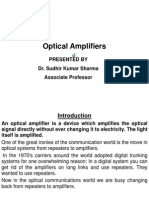Professional Documents
Culture Documents
Presentation 1
Presentation 1
Uploaded by
Pankaj GargOriginal Description:
Original Title
Copyright
Available Formats
Share this document
Did you find this document useful?
Is this content inappropriate?
Report this DocumentCopyright:
Available Formats
Presentation 1
Presentation 1
Uploaded by
Pankaj GargCopyright:
Available Formats
OPTICAL AMPLIFIER
(SOAs)
SUBMITTED BY:
ADITI
CHAUDHARY
ANSHU MATHUR
BHAVYADEEP
KAUR
SEEMA SHRIPAT
SUBMITTED TO:
Mr. SANJAY
SHARMA
Optical amplifier
#a device that amplifies
an optical signal directly
#no need to convert optical signal to electrical
signal
#used in OPTICAL COMMUNICATION and
LASER
Physics
Traditional Optical Communication
System
Loss compensation: Repeaters at every 20-50 km
Optically Amplified Systems
EDFA = Erbium Doped Fibre Amplifier
Optical Amplification
Variety of optical amplifier types exist, including:
Semiconductor optical amplifiers
Optical fiber amplifiers (Erbium Doped Fiber Amplifiers)
Distributed fiber amplifiers (Raman Amplifiers)
Optical fiber amplifiers are now the most common type
One of the most successful optical processing functions
Also used as a building block in DWDM systems
OFAs in the Network
Several attractive features for network use:
Relatively simple construction
Reliable, due to the number of passive
components
Allows easy connection to external fibers
Broadband operation > 20 nm
Bit rate transparent
Ideally suited to long span systems
Integral part of DWDM systems
Undersea applications for OFAs are now
common
Optical Amplifier Applications
Amplifier Applications
Preamplifiers
An optical preamplifier is placed immediately before a receiver to improve its sensitivity.
Since the input signal level is usually very low a low noise characteristic is essential.
However, only a moderate gain figure is needed since the signal is being fed directly into
a receiver.
Typically a preamplifier will not have feedback control as it can be run well below
saturation.
Power amplifiers
Most DFB lasers have an output of only around 2mW but a fibre can aggregate power
levels of up to 100 to 200mW before nonlinear effects start to occur. A power amplifier
may be employed to boost the signal immediately following the transmitter. Typical EDFA
power amplifiers have an output of around 100mW.
Line amplifiers
In this application the amplifier replaces a repeater within a long communication line. In
many situations there will be multiple amplifiers sited at way-points along a long link.
Both high gain at the input and high power output are needed while maintaining a very
low noise figure. This is really a preamplifier cascaded with a power amplifier.
Sophisticated line amplifiers today tend to be made just this way - as a multi-section
amplifier separated by an isolator.
Types of Optical Amplifiers :
LASER Amplifiers
*Doped Fiber Amplifiers
*Bulk Laser
# Stimulated emission in the amplifier's gain
medium causes amplification of incoming light.
#Commonly used to produce high power laser
systems.
#Almost any laser active gain medium can
be pumped to produce gain for light at the
wavelength of a laser made with the same
material as its gain medium.
LASER AMPLIFIER
Types of Optical Amplifiers :
OPTICAL PARAMETRIC Amplifiers
# Used in expanding the frequency tunability
of ultrafast solid-state lasers (e.g. Ti :
sapphire).
#allows the amplification of a weak Signal-
Impulse in a non-centrosymmetric nonlinear
medium (e.g. BBO).
# capable of extremely broad amplification
bandwidths.
Types of Optical Amplifiers :
RAMAN Amplifiers
# The signal is intensified by Raman
amplification
# Amplification uses Raman scattering of light
with phonons in the lattice of the gain
medium
#amplification effect is achieved by a nonlinear
interaction between the signal and a pump
laser within an optical fiber.
# Pump power requirement is high.
Types of Optical Amplifiers
RAMAN amplifier continued:
# TYPES
1) Distributed-
Transmission fiber is used as gain
medium
It may use 500mW of pump-power
2) Lumped
Utilizes a dedicated, shorter length
of fiber to provide amplification.
May use over 1W of optical power.
Types of Optical Amplifiers
RAMAN amplifier continued...
# Advantages-
1)able to provide distributed amplification
within the
transmission fiber
2)amplification can be provided over wider,
and
different regions.
SOA (Semiconductor Opt.
Amp.)
Primary candidates for all optical integrated
functional devices.
These are basically LASER diodes, modified
to remove lasing effect.
uses a semiconductor to provide the gain
medium.
have a similar structure to Fabry-Prot laser
diodes but with anti-reflection design elements
at the end-faces..
This creates a loss of power from the cavity
which is greater than the gain it prevents the
amplifier from acting as a laser.
SOA
typically made from group III-V compound
semiconductors such as GaAs/AlGaAs.
Often used in telecommunication systems in
the form of fiber-pigtailed components,
operating at signal wavelengths between
0.85 m and 1.6 m and generating gains of
up to 30 dB.
They are electrically pumped.
SOA
Types of SOA
1) Quantum Wave
(QW) amplifier
# the amplifier
gain will react
quickly to
changes in the
input power.
Types of SOA
2)Travelling
Wave(TW)
# the Fabry-Perot
cavity resonances is
suppressed
# for this the
reflectivity is reduced.
# Three approaches
are commonly used:
a)Anti-reflection
coating
b)Tilted Active Region
c)Use of transparent
window regions
Amplifier Bandwidths
Comparison of the bandwidths of Fabry
Perot and Traveling wave amplifiers
Saturation Power
Semiconductor
Optical amplifiers
saturate similarly
to a 2 level atom
The typical
saturation output
power for SOAs is
around 5-10mW
Types of SOAs continued..
Gain Clamped(GC) SOAs
#Gain is stabilized across signal
strengths but overall gain is lower than
a standard QW SOA
#Based on Distributed Bragg
Reflector(DBR)
technology
Quantum Dot(QD) SOAs
#Active region consists of a no. of low
dimensional
dot structures
#Gain of QD is small
Crosstalk in Semiconductor
Amplifiers
Rate equation for pump
current
If suddenly goes to
zero, as in 1-0
sequence
Time constant is
If suddenly turns on,
which is smaller
| | ) ( ) (
) (
0
t N t N
n
ac t N
qLWD
I
dt
dN
u
I
=
t
| |
t
t
/
1 ) (
t
e
qLWD
I
t N
=
t =
down
T
1
1
|
.
|
\
|
u I
+ =
n
ac
T
up
t
Parameters on previous slide
N=carrier density (cm
-3
)
I=pump current (amp= coul/s)
q=charge on electron (coul)
L, w, d=cavity dimensions (cm
3
)
t=recombination lifetime (s)
I=confinement factor (unit less)
u=photon density (cm
-3
)
a=gain coefficient (cm
-1
)
Crosstalk continued
If time constant for spontaneous decay
of excited state is shorter than the bit
duration, the population of the excited
state will vary sharply with the optical
power in the fiber, and gain will depend
on the fraction of 1s and 0s in the data
stream.
If time constant is long, then the
population in the excited state will be
constant, dependent upon the pump
power but not the signal power.
Undesired effects in an
SOA
Cross saturation can cause undesired
coupling between channels
This can be used for wave length
conversion and controlling light with
light
If used for multiple channels in a
switched network gain must be adjusted
as channels are added and dropped
Four wave mixing is also quite
pronounced in SOAs
Causes undesired coupling of light
between channels
Can however also be used to
advantage in wavelength converters.
High coupling loss
Polarization sensitive gain
Semiconductor amplifier
advantages
Can easily be integrated as preamplifiers at the
receiver end
Use same technology as diode lasers
Gain relatively independent of wavelength
Are pumped with current, not another laser
Low power consumption
Less expensive than EDFA
4 types of non-linear operations can be
performed(cross gain modulation, cross phase
modulation, wavelength conversion and four
wave mixing)
Semiconductor amplifier
disadvantages
Moderate Polarization dependence
Self-phase modulation leading to chirp
Cross-phase modulation
Four-wave mixing and crosstalk
Extremely short (ns) excited state lifetimes
Lower Gain
SOA Applications
Booster amplifiers
In-Live amplifiers
Pre-amplifiers
Wavelength conversion/selection/regeneration
Mid-Span Spectral Inversion
As Multiplexers
Optical Gates
You might also like
- Xs Analyse Service ManualDocument170 pagesXs Analyse Service ManualPablo A. Flores78% (9)
- Fiber Optical Interview Questions and Answers-Optical QuestionnaireDocument49 pagesFiber Optical Interview Questions and Answers-Optical QuestionnaireBahzad100% (1)
- DWDM Introduction-PSS 1830 COMMISSIONING GUIDEDocument118 pagesDWDM Introduction-PSS 1830 COMMISSIONING GUIDEمحمد فاضل0% (1)
- Beckercom: Welcome To The Becker ElectronicsDocument68 pagesBeckercom: Welcome To The Becker ElectronicsMichael Erdis50% (2)
- Optical MultiplexerDocument15 pagesOptical Multiplexereabhishek22250% (2)
- Optical AmplifiersDocument34 pagesOptical Amplifierspriyasingh1682No ratings yet
- Optical Amplifiers: Presented BY Dr. Sudhir Kumar Sharma Associate ProfessorDocument33 pagesOptical Amplifiers: Presented BY Dr. Sudhir Kumar Sharma Associate ProfessorAnkit DattNo ratings yet
- Chapter 11 Optical Amplifiers PDFDocument62 pagesChapter 11 Optical Amplifiers PDFSurya TripathiNo ratings yet
- Optical Amplifiers Oct 23Document8 pagesOptical Amplifiers Oct 23Sudarshan ChauhanNo ratings yet
- Optical Network ElementsDocument49 pagesOptical Network ElementsRaghu Babu Panjaa100% (1)
- Chapter 6 Optical AmplifiersDocument40 pagesChapter 6 Optical AmplifiersEng Burhaanudiin Cumar0% (1)
- Module 4.optical AmplifiersDocument30 pagesModule 4.optical AmplifiersPreetham M. C Preetham M. CNo ratings yet
- UNIT.8.Optical AmplifiersDocument31 pagesUNIT.8.Optical AmplifiersNandan GowdaNo ratings yet
- Chapter 6 Optical AmplifiersDocument40 pagesChapter 6 Optical AmplifiersThasnimFathimaNo ratings yet
- EDFA Amplifier Raman Amplifier Semiconductor Amplifier: A Comparison Based StudyDocument61 pagesEDFA Amplifier Raman Amplifier Semiconductor Amplifier: A Comparison Based StudySanjay YadavNo ratings yet
- Group 7Document30 pagesGroup 7edwardNo ratings yet
- Lec-10 Amplifiers Contd (09 Mar, 2017)Document41 pagesLec-10 Amplifiers Contd (09 Mar, 2017)Mehreen AfridiNo ratings yet
- An Introduction To Microwave Amplifiers Part 1 - Microwave Amplifier Applications - Marki Microwave RF & MicrowaveDocument7 pagesAn Introduction To Microwave Amplifiers Part 1 - Microwave Amplifier Applications - Marki Microwave RF & MicrowaveRAJKUMARSCRIBD_123No ratings yet
- Optical Amplifier EDFA: NtroductionDocument3 pagesOptical Amplifier EDFA: NtroductionTareq QaziNo ratings yet
- Optical NetworksDocument83 pagesOptical Networksinfant_charlesNo ratings yet
- Unit 9 - Optical AmplifierDocument55 pagesUnit 9 - Optical Amplifiervidyasawant2012No ratings yet
- Erbium-Doped Fiber AmplifiersDocument6 pagesErbium-Doped Fiber AmplifiersboyetcincoNo ratings yet
- Wideband Optical Amplifiers Raman Amplifiers: Ofc Seminar 9 December 2010Document18 pagesWideband Optical Amplifiers Raman Amplifiers: Ofc Seminar 9 December 2010deepak_karkalaNo ratings yet
- Presented By:: Suneel MiriyalaDocument39 pagesPresented By:: Suneel MiriyalasuneelNo ratings yet
- Ofc Module - 03Document7 pagesOfc Module - 03shameem v.pNo ratings yet
- Lecture 9 - Optical AmplifiersDocument24 pagesLecture 9 - Optical AmplifiersRodNo ratings yet
- Introduction To Optical AmplifiersDocument6 pagesIntroduction To Optical AmplifiersMohanish PareekNo ratings yet
- Optical Amp 1Document63 pagesOptical Amp 1yusvelysNo ratings yet
- ECEg4302 - Chapter FourDocument11 pagesECEg4302 - Chapter FourAmanuel AdmassuNo ratings yet
- Comparison Among Fiber AmplifiersDocument61 pagesComparison Among Fiber AmplifiersMohammed KumaylNo ratings yet
- Optical Amplification, Wavelength Conversion and RegenerationDocument15 pagesOptical Amplification, Wavelength Conversion and Regenerationfatimah.albadiri.ms9No ratings yet
- Raman Amplifier ThesisDocument5 pagesRaman Amplifier Thesisdwnt5e3k100% (2)
- EE 230: Optical Fiber Communication Lecture 7: Optical Amplifiers-The BasicsDocument28 pagesEE 230: Optical Fiber Communication Lecture 7: Optical Amplifiers-The BasicsSayed HashemNo ratings yet
- 2012IR Audio LinkDocument5 pages2012IR Audio LinkAnkush SilhiNo ratings yet
- Chapter-1 Optical Fiber CommunicationDocument24 pagesChapter-1 Optical Fiber CommunicationAkhil GargNo ratings yet
- Essential Properties of Narrowband Amplifier and How It Compares To Wideband AmplifierDocument8 pagesEssential Properties of Narrowband Amplifier and How It Compares To Wideband AmplifierjackNo ratings yet
- 6.0. OFC - Optical Amplifiers - 2024Document38 pages6.0. OFC - Optical Amplifiers - 2024jayeshshin18No ratings yet
- Fiber Optics - 5Document43 pagesFiber Optics - 5anishaantexNo ratings yet
- Komponen Sistem Komunikasi Serat OptikDocument84 pagesKomponen Sistem Komunikasi Serat OptikGamaliel SyikalNo ratings yet
- Cs 401 Assignment Group 9Document9 pagesCs 401 Assignment Group 9Rajendra Prasad SasmalNo ratings yet
- Optical Amplifiers in Single Channel and WDM Systems Nonlinear Effects in FiberDocument24 pagesOptical Amplifiers in Single Channel and WDM Systems Nonlinear Effects in FiberGaurav AgrawalNo ratings yet
- Complete Analysis of Erbium-Doped Fiber Amplifiers: Technical PaperDocument15 pagesComplete Analysis of Erbium-Doped Fiber Amplifiers: Technical Paperhanhnguyen2003No ratings yet
- Assignment OFC ECDocument6 pagesAssignment OFC ECYash AwasthiNo ratings yet
- Laser Torch Based Voice Transmitter and Receiver (Repaired)Document56 pagesLaser Torch Based Voice Transmitter and Receiver (Repaired)1deakz4lu7ge100% (3)
- U2 TransceiversDocument27 pagesU2 TransceiversmpoornishwarNo ratings yet
- Unit 4 FOCDocument26 pagesUnit 4 FOCNAGASWATHI NIDAMANURINo ratings yet
- A Fully Integrated Radio-Fiber InterfaceDocument3 pagesA Fully Integrated Radio-Fiber InterfaceSana FatimaNo ratings yet
- Tunable Laser Technology: Technical Seminar-IDocument15 pagesTunable Laser Technology: Technical Seminar-IYemula Ajay100% (1)
- Linewidth Enhancement FactorDocument2 pagesLinewidth Enhancement FactorNikam Jayeshkumar JairamNo ratings yet
- Silo - Tips - White Paper Power Booster EdfaDocument7 pagesSilo - Tips - White Paper Power Booster Edfadeshraj34No ratings yet
- So A TutorialDocument3 pagesSo A TutorialrjkadivarNo ratings yet
- Module 5Document72 pagesModule 5Kamalendu C MenonNo ratings yet
- RF BALUNsDocument4 pagesRF BALUNsMahmoud ShaabanNo ratings yet
- Raman EffectDocument14 pagesRaman EffectMeenakshi DhasmanaNo ratings yet
- RFoF Link Design GuidelineDocument12 pagesRFoF Link Design GuidelineSantosh KumarNo ratings yet
- Radio Frequency Over Optical FiberDocument31 pagesRadio Frequency Over Optical Fibersiva kumar mandhatiNo ratings yet
- Amateur Radio Electronics on Your MobileFrom EverandAmateur Radio Electronics on Your MobileRating: 5 out of 5 stars5/5 (1)
- January 2015 Current AffairsDocument72 pagesJanuary 2015 Current AffairsReema KumariNo ratings yet
- Subject Wise Registration DetailsDocument34 pagesSubject Wise Registration DetailsPankaj GargNo ratings yet
- ListDocument3 pagesListPankaj GargNo ratings yet
- B.Tech Tutorial CAD Algorithm For Synthesis of Digital SystemsDocument2 pagesB.Tech Tutorial CAD Algorithm For Synthesis of Digital SystemsPankaj GargNo ratings yet
- Capital Structure Analysis: TVS Motor CompanyDocument11 pagesCapital Structure Analysis: TVS Motor CompanyPankaj GargNo ratings yet
- Light Runner Kit: Experiment No.: 5Document3 pagesLight Runner Kit: Experiment No.: 5Pankaj GargNo ratings yet
- Experiment No.-2 Ed-Lase: 1. Object IveDocument4 pagesExperiment No.-2 Ed-Lase: 1. Object IvePankaj GargNo ratings yet
- Experiment No.2Document10 pagesExperiment No.2Pankaj GargNo ratings yet
- Ed-Com Kit: Experiment No.: 1Document2 pagesEd-Com Kit: Experiment No.: 1Pankaj GargNo ratings yet
- Step Index and Graded Index FiberDocument23 pagesStep Index and Graded Index FiberPankaj Garg0% (2)
- Exp 4Document6 pagesExp 4Pankaj GargNo ratings yet
- Experiment No.-3 Ed-Lase: 1. ObjectiveDocument4 pagesExperiment No.-3 Ed-Lase: 1. ObjectivePankaj GargNo ratings yet
- Comment On The Political Implications of The Death of The AuthorDocument73 pagesComment On The Political Implications of The Death of The AuthorSunup TzudirNo ratings yet
- SFE BMP180 ExampleDocument4 pagesSFE BMP180 ExampleJustin ShearerNo ratings yet
- Review Materi AjarDocument17 pagesReview Materi AjarPuji UtamiNo ratings yet
- GRAU DATA GAM Service DocumentDocument9 pagesGRAU DATA GAM Service DocumentSekhar DashNo ratings yet
- Remember The Titans (ANALYSIS)Document2 pagesRemember The Titans (ANALYSIS)sonu_saisNo ratings yet
- Hard Real Time Linux Using Xenomai On Intel® Multi-Core ProcessorsDocument31 pagesHard Real Time Linux Using Xenomai On Intel® Multi-Core ProcessorsschrankmannNo ratings yet
- Gauss ElimDocument8 pagesGauss ElimRachmawati BadrudinNo ratings yet
- Dhis2 Android User ManDocument28 pagesDhis2 Android User MankobedeolNo ratings yet
- 9th Maths Number System Test Paper WorksheetDocument8 pages9th Maths Number System Test Paper WorksheetChirag GargNo ratings yet
- Storage MigrationPVmoveDocument6 pagesStorage MigrationPVmovenvns17No ratings yet
- School Science Curriculum (SMP) (Hbsc3303)Document5 pagesSchool Science Curriculum (SMP) (Hbsc3303)alifhamindal100% (1)
- Rethinking Learning: Carl Bereiter Marlene ScardamaliaDocument23 pagesRethinking Learning: Carl Bereiter Marlene ScardamaliaJ. Félix Angulo RascoNo ratings yet
- Flood Geology by CMIDocument108 pagesFlood Geology by CMI7ett_0% (3)
- PerfectDisk Statistics HPENVYLEAPMOTIO Windows C 2017.06.29 06.03PMDocument5 pagesPerfectDisk Statistics HPENVYLEAPMOTIO Windows C 2017.06.29 06.03PMVlad MusicNo ratings yet
- Strong Thesis Statement About EducationDocument7 pagesStrong Thesis Statement About Educationpwqlnolkd100% (1)
- Inertial Explorer New FeaturesDocument26 pagesInertial Explorer New FeaturesbimoNo ratings yet
- Thrust Force Prediction of Twist Drill Tools Using A 3DDocument16 pagesThrust Force Prediction of Twist Drill Tools Using A 3DNguyen Danh TuyenNo ratings yet
- Gold Student Guide NuffieldDocument8 pagesGold Student Guide NuffieldIntesar NurNo ratings yet
- Application Form NGSE ERDTDocument9 pagesApplication Form NGSE ERDTRa-ed FigueroaNo ratings yet
- Same Day Thesis BindingDocument8 pagesSame Day Thesis Bindinghcivczwff100% (2)
- TOS Math 4 q4Document7 pagesTOS Math 4 q4jemar.limatoNo ratings yet
- Digital India and Interdisciplinary ResearchDocument5 pagesDigital India and Interdisciplinary ResearchSavitesh KushwahaNo ratings yet
- Preventive and Planned Maintenance of Elevators: June 2001Document9 pagesPreventive and Planned Maintenance of Elevators: June 2001Kenneth PascuaNo ratings yet
- 5 /6 Grade Math Syllabus Ann Marie May 1. (Before School Starts) Now-End of AugustDocument3 pages5 /6 Grade Math Syllabus Ann Marie May 1. (Before School Starts) Now-End of Augustapi-519706048No ratings yet
- IMPROVEMENT OF KABUNDI COPPER CATHODE RECOVERY BY ESTABLISHING AND EXPLOITING THE RELATIONSHIP BETWEEN TANKLOADING PRACTICE, REJECTION FACTORS AND REJECTION RATES AT KCM TAILINGS LEACH PLANT TANK HOUSE NCHANGA INTEGRATED BUSINESS UNIT (NIBU)Document89 pagesIMPROVEMENT OF KABUNDI COPPER CATHODE RECOVERY BY ESTABLISHING AND EXPLOITING THE RELATIONSHIP BETWEEN TANKLOADING PRACTICE, REJECTION FACTORS AND REJECTION RATES AT KCM TAILINGS LEACH PLANT TANK HOUSE NCHANGA INTEGRATED BUSINESS UNIT (NIBU)moses chilekwaNo ratings yet
- Competency FrameworkDocument53 pagesCompetency FrameworkFadlyIbrahimNo ratings yet
- Scroll Down To Read The ArticleDocument19 pagesScroll Down To Read The ArticleChukwukadibia E. NwaforNo ratings yet
- Oxygen Cycle PPT Slides PDFDocument15 pagesOxygen Cycle PPT Slides PDFFany FabiaNo ratings yet
- Piacenza Re-Loaded: North-South CorridorsDocument34 pagesPiacenza Re-Loaded: North-South CorridorsGouri RavikumarNo ratings yet





































































































